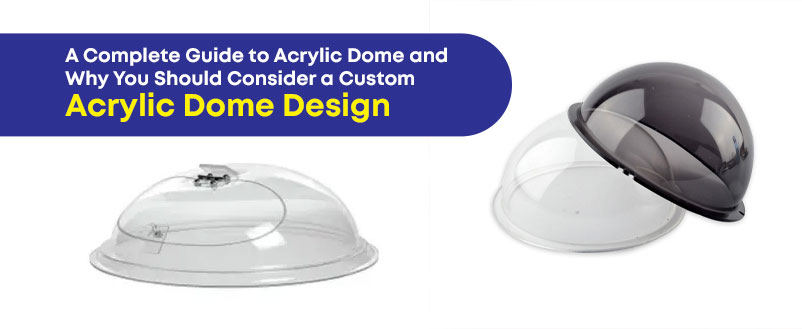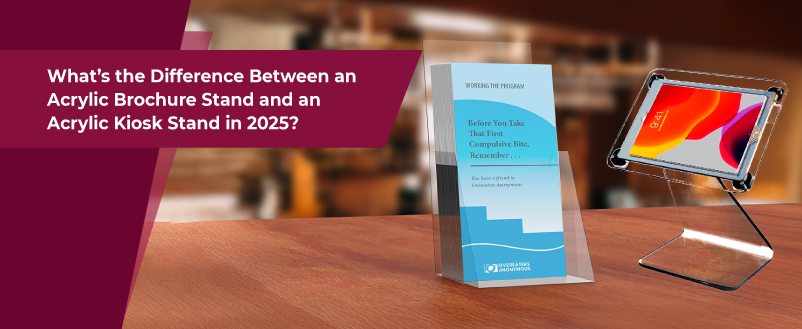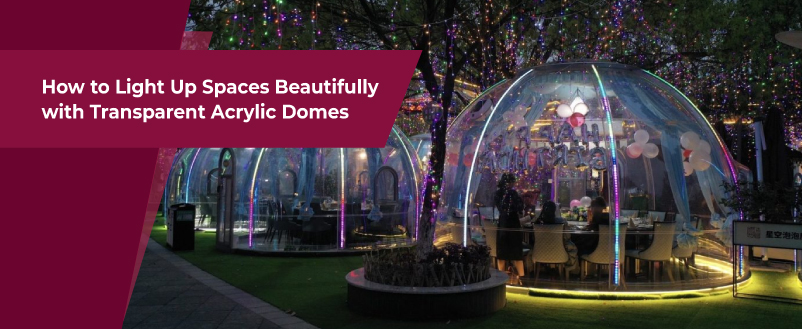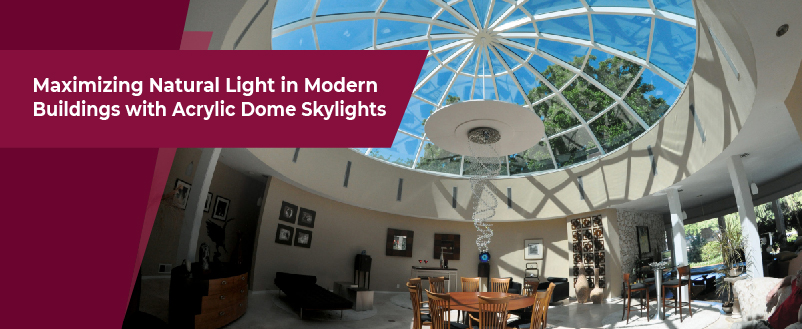
In contemporary architecture, harnessing natural light is paramount for creating inviting, sustainable spaces. Skylights play a pivotal role in this pursuit, channeling sunlight to illuminate interiors and reduce reliance on artificial lighting. Among these, acrylic dome skylights stand out for their versatility and efficiency. In this blog, we explore how acrylic dome skylights optimize daylighting, enhance energy efficiency, and infuse modern buildings with a luminous ambiance. Join us as we delve into the transformative potential of acrylic dome skylights in maximizing direct sunlight within architectural spaces.
Table of Content
What are acrylic dome skylights?
Acrylic dome skylights are crafted from acrylic, a type of plastic known for its clarity, durability, and weather resistance. The dome shape is a common design choice as it maximizes the amount of direct sunlight entering the building while providing structural strength and protection against the elements. Acrylic dome skylights are available in various sizes and configurations to suit different architectural styles and project requirements.
Advantages over traditional skylight materials
Acrylic dome skylights offer several advantages over traditional skylight materials such as glass or polycarbonate:
- Lightweight:
Acrylic is significantly lighter than glass, making it easier to install and reducing the structural load on the building.
- Impact resistance:
Acrylic is highly impact-resistant, making it less prone to breakage than glass or polycarbonate.
- UV protection:
Many acrylic dome skylights come with built-in UV protection, preventing the transmission of harmful ultraviolet rays while still allowing visible light to pass through.
- Thermal insulation:
Acrylic has good thermal insulation properties and is suitable for low-energy buildings, helping to reduce heat loss in colder climates and heat gain in warmer climates.
- Design flexibility:
Acrylic can be molded into various shapes and sizes, allowing for greater design flexibility, efficient daylighting, and customization options for smart homes.
- Cost-effectiveness:
Acrylic dome skylights are often more affordable than glass skylights, minimizing energy costs for commercial buildings and residential projects.
Types of acrylic dome skylights available in the market
There are several types of acrylic dome skylights available in the market, each offering unique features and benefits:
- Fixed dome skylights:
Fixed dome skylights are stationary and cannot be opened or closed. They are a popular choice for providing consistent natural light solutions in areas without ventilation.
- Ventilated dome skylights:
Ventilated dome skylights feature hinged or operable openings that allow for natural lighting ventilation in addition to daylighting. They are ideal for areas where airflow and fresh air circulation are desired.
- Tubular skylights:
Tubular skylights, also known as sun tunnels or solar tubes, consist of a small acrylic dome on the roof connected to a reflective tube that directs sunlight into interior spaces. These tubular daylighting devices are a space-saving alternative to traditional skylights and are often used in smaller rooms or areas with limited ceiling space.
- Custom skylights:
Some manufacturers offer custom acrylic dome skylights tailored to specific project requirements, including non-standard shapes, sizes, and configurations.
Exploring the Uses of Acrylic Domes in Architecture and Design, we find that these elements are not only functional but also contribute significantly to the aesthetic and environmental sustainability of modern constructions.
Benefits of Acrylic Dome Skylights
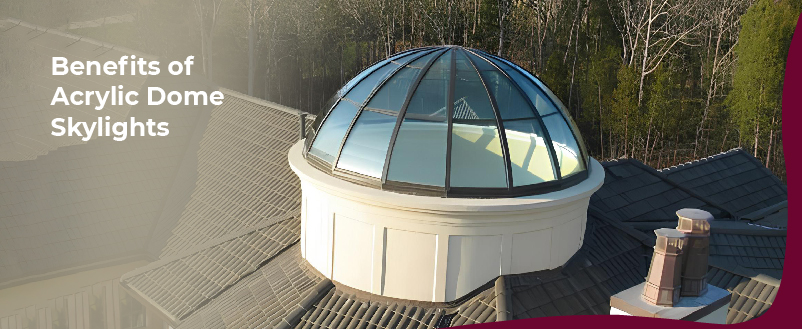
Acrylic dome skylights offer a multitude of benefits that make them a popular choice for maximizing natural light in modern buildings. Here are some key advantages:
Increased daylighting:
Acrylic dome skylights allow abundant natural light to flood interior spaces, creating a bright and inviting atmosphere. By harnessing daylight, these skylights reduce the need for artificial lighting during daylight hours, lowering energy consumption and utility costs. The diffuse, even illumination skylights provide enhanced visual comfort and productivity while minimizing glare and shadows.
Energy efficiency:
Acrylic dome skylights contribute to the overall energy savings and efficiency of a building by reducing reliance on artificial light and lowering heating and cooling loads. The abundant natural light level they provide helps to offset electricity usage for lighting, leading to significant energy savings over time. Additionally, skylights with thermal insulation properties help to regulate indoor temperatures, reducing the need for heating and cooling systems and further improving energy efficiency and sustainable lifestyle.
Durability and longevity:
Acrylic dome skylights are known for their durability and longevity, making them a reliable choice for architectural daylighting solutions. Acrylic is highly impact-resistant and can withstand extreme weather conditions, including hail, heavy rain, and strong winds, without cracking or breaking. Unlike glass skylights, acrylic dome skylights are less prone to environmental impact like shattering, making them a safer option in high-traffic or vulnerable areas of outdoor spaces. Additionally, acrylic skylights are resistant to discoloration and yellowing over time, maintaining their clarity and aesthetics for years to come.
Design versatility:
Acrylic dome skylights offer unparalleled design versatility, allowing architects and designers to create visually stunning and innovative spaces. Available in various shapes, sizes, and configurations, acrylic skylights can be customized to suit a wide range of architectural styles including modern building designs and project requirements. Whether used in residential, commercial, or institutional buildings, acrylic dome skylights can be seamlessly integrated into the overall design, enhancing the aesthetic appeal and functionality of the space of sustainable buildings. From fixed domes to ventilated skylights to tubular sun tunnels, there are endless possibilities for incorporating acrylic dome skylights into the architectural project design process.
Factors to Consider When Installing Acrylic Dome Skylights
Building orientation and location:
The orientation and location of the sustainable buildings will determine the amount and angle of sunlight received throughout the day. Consideration should be given to positioning the skylights on the roof to maximize exposure to natural light while minimizing potential issues such as glare and overheating.
Size and placement of skylights:
The size and placement of acrylic dome skylights will impact the distribution of natural light within the interior spaces. Factors such as room size, ceiling height, and desired lighting levels should be taken into account when determining the number and dimensions of skylights needed. Additionally, strategic placement of skylights can help optimize daylighting while minimizing heat gain and loss.
Thermal performance and insulation:
Acrylic dome skylights should be selected based on their thermal performance and insulation properties to minimize heat transfer and maintain comfortable indoor temperatures. Look for skylights with double or triple glazing, low-emissivity coatings, and thermal breaks to enhance energy efficiency and reduce heating and cooling costs.
Maintenance requirements:
Regular maintenance is essential to ensure the long-term performance and durability of acrylic dome skylights. Consider factors such as accessibility for cleaning, inspection, and repair when determining the placement and installation method of skylights. Additionally, choose skylights with easy-to-clean surfaces and durable materials to simplify maintenance tasks and prolong the lifespan of the skylight system.
Design Tips for Maximizing Natural Light with Acrylic Dome Skylights
Designing spaces that maximize natural light with acrylic dome skylights involves strategic planning and integration within the architectural framework. Here are some design tips to achieve optimal daylighting:
Integrating skylights into architectural design:
Consider the building’s layout and function: Determine which areas would benefit most from natural light, such as living rooms, kitchens, or workspaces.
- Roof design and structure: Work with the building’s roof design to seamlessly integrate acrylic dome skylights into the architectural aesthetic. Consider incorporating skylights into sloped or flat roofs, or even creating a central atrium to allow light to penetrate multiple levels.
- Scale and proportion: Ensure that the size and placement of skylights are proportional to the scale of the space and the overall building design. Avoid overcrowding or overwhelming smaller rooms with oversized skylights.
Combining skylights with other daylighting strategies:
- Windows and glass doors: Coordinate the placement of skylights with windows and glass doors to create a balanced distribution of natural light throughout the space. This allows for cross-ventilation and enhances visual connectivity between indoor and outdoor areas.
- Light shelves and reflective surfaces: Install light shelves or reflective surfaces near skylights to redirect sunlight deeper into the interior and minimize glare. This technique helps to evenly distribute light and reduce the need for artificial lighting during daylight hours.
- Interior layout and furniture placement: Arrange interior spaces and furniture to optimize the diffusion of natural light from skylights. Position workstations, seating areas, and task areas to take advantage of daylighting while minimizing glare and shadows.
Using light diffusers and controls for optimal lighting:
- Light diffusing materials: Install light diffusers or translucent materials beneath skylights to soften and evenly distribute natural light throughout the space. This helps to minimize harsh shadows and glare, creating a more comfortable and visually pleasing environment.
- Motorized blinds or shades: Incorporate motorized blinds or shades into skylight designs to provide adjustable shading and glare control. Automated controls can adjust the amount of incoming light based on time of day, season, or user preferences, optimizing daylighting and energy efficiency.
- Daylight harvesting systems: Implement daylight harvesting systems that integrate sensors and controls to automatically adjust artificial lighting levels in response to available natural light. This dynamic lighting strategy maximizes energy savings while maintaining consistent illumination levels and visual comfort.
By incorporating these design tips, architects and designers can effectively harness the benefits of acrylic dome skylights to create naturally illuminated, visually engaging, and energy-efficient spaces. Additionally, you can check the skylight installation guide for more tips.
Conclusion
Acrylic dome skylights represent a transformative solution for maximizing natural light in modern buildings. Enabling space for more passive daylighting systems, energy efficiency, durability, and design versatility significantly enhances the quality of indoor environments. Additionally, it reduces reliance on artificial lighting and improves overall sustainability. With their ability to create bright, inviting spaces that foster well-being and productivity, acrylic dome skylights are a valuable addition to sustainable architecture. By harnessing the power of natural light, we can create spaces that not only meet the needs of occupants but also contribute to a more sustainable and environmentally friendly built environment.
Also read: Guide to Acrylic Dome and Why You Should Consider a Custom Acrylic Dome Design
Pleasant Acrylic specializes in acrylic industry and upholstery services in Dubai, providing comprehensive precision engineering and tooling through Acrylic Design Dubai. Recognized as premier outstanding Acrylic Dome Manufacturers in Dubai they deliver superior products suited for multiple uses. They are also known for their role as Acrylic Signage Board Suppliers Dubai where they ensure all products align with the highest sustainability and aesthetic standards.
